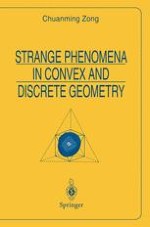1996 | OriginalPaper | Chapter
The Busemann-Petty Problem
Authors : Chuanming Zong, James J. Dudziak
Published in: Strange Phenomena in Convex and Discrete Geometry
Publisher: Springer New York
Included in: Professional Book Archive
Activate our intelligent search to find suitable subject content or patents.
Select sections of text to find matching patents with Artificial Intelligence. powered by
Select sections of text to find additional relevant content using AI-assisted search. powered by
The search for relationships between a convex body and its projections or sections has a long history. In 1841, A. Cauchy found that the surface area of a convex body can be expressed in terms of the areas of its projections as follows: $$s\left( K \right) = \frac{1}{{{\omega _{n - 1}}}}\int_{\partial \left( B \right)} {\bar v\left( {{P_u}\left( K \right)} \right)d\lambda \left( u \right)} .$$ Here, s(K) denotes the surface area of a convex body K ⊂ Rn, $$\bar v\left( X \right)$$ denotes the (n − 1)-dimensional “area” of a set X ⊂ Rn−1, P u denotes the orthogonal projection from Rn to the hyperplane H u = {x ∈ Rn: 〈x, u〉 = 0} determined by a unit vector u of Rn, and λ denotes surface-area measure on ∂(B). In contrast, the closely related problem of finding an expression for the volume of K in terms of the areas of its projections P u (K) (or the areas of its sections I u (K) = K ⋂ H u ) proved to be unexpectedly and extremely difficult.
